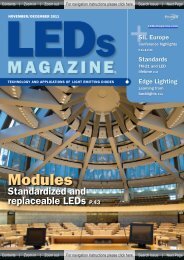Zoom In - Beriled
Zoom In - Beriled
Zoom In - Beriled
- No tags were found...
You also want an ePaper? Increase the reach of your titles
YUMPU automatically turns print PDFs into web optimized ePapers that Google loves.
Previous Page | Contents | <strong>Zoom</strong> in | <strong>Zoom</strong> out | Front Cover | Search Issue | Next PageABE FMaGSlighting | DIRECTIONALDesigning with LED directional lights:the importance of delivering lux on targetThe quality of light and the amount of light reaching the targeted area are the most important factorsin directional lighting applications, explains QUATA OCANO.LEDs are known for their potentialenergy savings and longservice life, and LED lightingis often touted for its luminous efficacyas measured in lumens per watt(lm/W). However, lm/W is not the bestperformance measure for directionallighting applications (Fig. 1) such asspot, accent and task lighting. <strong>In</strong> theseapplications, manufacturers need todesign lamps and modules that maximizethe delivered light or “usablelumens” rather than the lm/W value.Focus on usable lightThe two most important things toconsider when working with directionallight are, firstly, the amount oflight reaching the targeted area and,secondly, the quality of that light.“Unless LED products satisfy ourintensity, distribution and color renderingexpectations, we will not considerinstalling LED lamps and modules regardlessof their efficiency or cost-savings,” saysBradley Bouch, Senior Lighting Designer forWynn Design and Development. “Designershave been disappointed with LED lightsthat do not live up to their own specifications,much less the designers' expectations.LED manufacturers should simply take theirproduct and shine it on a wall next to a similarhalogen MR16.”He adds, “When the quality of light fromthe LED lamp is comparable to the halogenlamp and the product is dimmable, we willbe happy to use them. We are always lookingfor ways to improve energy efficiency, but notat the expense of the lighting quality.”<strong>In</strong> short, LED lighting manufacturersneed to design products with the emphasison the delivered light, and to provide thenecessary specifications that the designercan use to incorporate LED lights into theiroverall plans.IlluminanceThe “Holy Grails” for LED lighting over thelast 10 years have been lumens and luminousefficacy to compete with incandescent,halogen and CFL products in general lightingapplications. LEDs are inherently directionaland make excellent spot and floodlights if designed properly. However, traditionalLED light measurements are notappropriate and may be counterproductive.QUATA OCANO is senior product marketing manager with LedEngin <strong>In</strong>c. (www.ledengin.com), asolid-state lighting company based in Silicon Valley, California.FIG. 1. Directional lighting applications.<strong>In</strong> a spot or accent fixture, the objective isto highlight a specific feature or item suchas a painting or architectural element. Theonly light that matters is the light that illuminatesthe feature.The light in the target area, or illuminance,is measured in footcandles (lm/ ft 2 ),or lux (lm/m 2 ). Rather than focus on lumensor lm/W, light sources designed for directionallighting should emphasize beam angleand lux or footcandles in the center beam toprovide suitable solutions.Quality of lightThe quality of the light in the beam isalso important to accent lighting. This ismuch more subjective than the quantityof light and encompasses light uniformity,LEDsmagazine.com APRIL 2009 35Previous Page | Contents | <strong>Zoom</strong> in | <strong>Zoom</strong> out | Front Cover | Search Issue | Next PageABE FMaGS

















